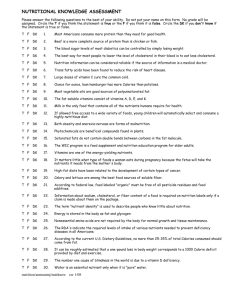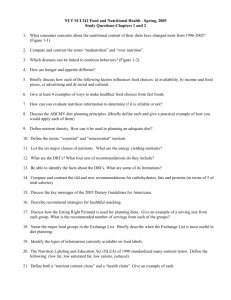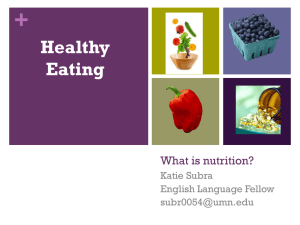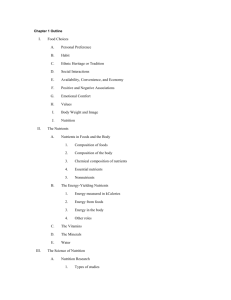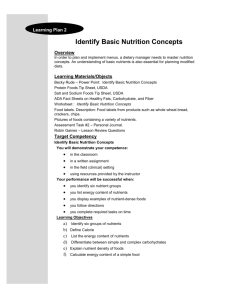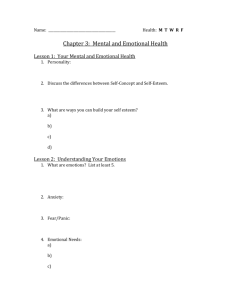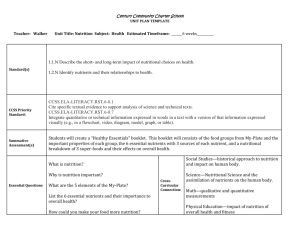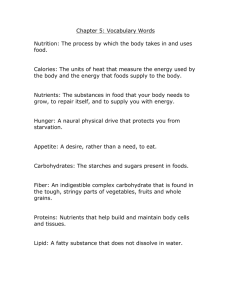An Overview of Nutrition
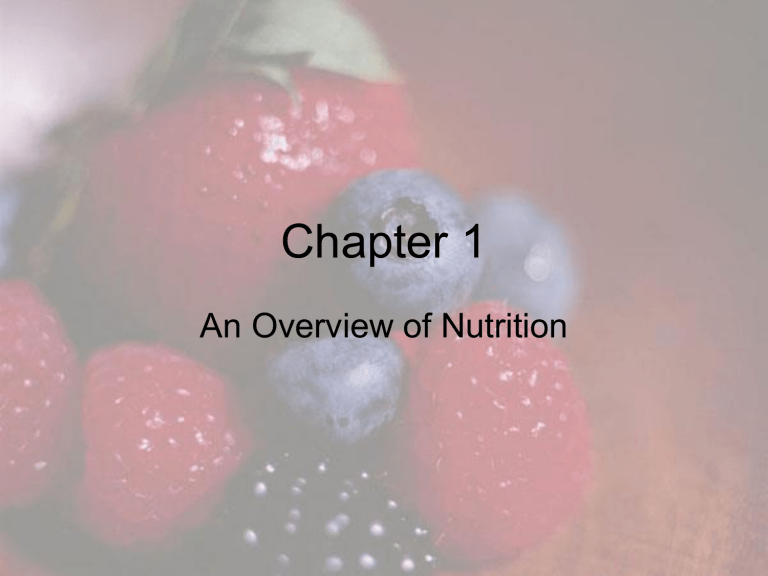
Chapter 1
An Overview of Nutrition
Chapter Objectives
• Identify the six classes of nutrients and determine which are energy-yielding nutrients.
• List four factors that affect our food choices.
• Explain why meeting nutrient needs by eating a well-balanced diet is a healthier choice than relying on supplements.
• Describe the steps of the scientific method.
• Discuss the three different types of research that scientists can use to test their hypothesis.
• List several factors to consider when obtaining nutrition information on the internet.
Overview of Nutrition
•Nutrition
–Science of foods and the substances they contain, their actions within the body
•Foods
–from plants or animal sources
–Provide energy and nutrients
–Used by the body for maintenance, growth, and repair
•Diet
–The foods one consumes.
–The quality of which affects the risk of chronic diseases
What Drives Our Food Choices?
We choose foods for many other reasons beyond the basic need to obtain nutrients:
• Taste
• Ethnic heritage or tradition
• Social interactions
• Advertising
• Availability, Convenience, and Economy
• Habits
• Emotional Comfort
• Body Weight and image
• Nutrition and Health Benefits
The Nutrients
We need to eat and drink to obtain:
– Nutrients: chemical compounds in foods to provide fuel for energy (measured in kilocalories), growth, maintenance and to regulate body processes
• Six classes: carbohydrates, fats, protein, vitamins, minerals, water
– Energy: The capacity to do work. The energy in food is chemical energy, it can be converted to mechanical energy in the body.
• Food energy is measured in calories
Meet the Nutrients
Six classes of Nutrients
• Water
• Carbohydrates
• Protein
• Fat
• Vitamins
• Minerals
The Nutrients
• Chemical composition of Nutrients
– Organic – contain carbon
• Carbohydrate
• Protein
• Lipids
• vitamins
– Inorganic – do not contain carbon
• Water
• minerals
The Nutrients
Essential nutrients
• Nutrients a person must obtain from food because the body cannot make them for itself in sufficient quantity to meet physiological needs.
Energy yielding nutrients (Macronutrients)
• The nutrients that break down to yield energy the body can use
– Carbohydrate
– Fat
– Protein
Energy-Yielding Nutrients
Calories and kilocalories
• Calories are units by which energy is measured. Food energy is measured in kilocalories (kcal)
– Carbohydrate = 4 kcal/gram
– Protein = 4 kcal/gram
– Fat 9 = kcal/gram
Energy from Foods
Energy density – a measure of the energy a food provides relative to the amount of food (kcal per gram)
• Lower energy density – provides low kcal per gram
• Higher energy density - provides high kcal per gram
Lower energy density
This 450-gram breakfast delivers 500 kcal, for an energy density of 1.1
(500 kcal/450 g = 1.1 kcal/g)
Higher energy density
This 144-gram breakfast delivers 500 kcal, for an energy density of 3.5
(500 kcal/144 g = 3.5 kcal/g)
Nutrients and Their Functions
Other Nutrients
• Vitamins
– Organic
– Not energy-yielding
– Essential nutrient
– Water-soluble vs. fat-soluble
– Vulnerable to destruction
• Minerals
– Inorganic
– Not energy-yielding
– Essential nutrient
– Indestructible
• Water
– Inorganic
– Not energy-yielding
– Essential nutrient
Dietary Reference Intakes (DRI)
Estimated Average Requirements -(EAR)
• defines the requirement of a nutrient that supports a specific function in the body for half of the healthy population.
Recommended Dietary Allowances – (RDA)
• use the EAR as a base
• include sufficient daily amounts of nutrients to meet the known nutrient needs of all healthy populations.
• This recommendation considers deficiencies.
Dietary Reference Intakes
• Adequate Intakes (AI)
– reflect the average daily amount of a nutrient without an established RDA that appears to be sufficient.
• Tolerable Upper Intake Level (UL)
– is a maximum daily amount of a nutrient that appears safe for most healthy people and beyond which there is an increased risk of adverse health effects.
Energy Recommendations
• Estimated Energy Requirement –EER
– average daily energy intake to maintain energy balance and good health for population groups.
• Acceptable Macronutrient Distribution
Ranges (AMDR)
– range of intakes for energy nutrients that provide adequate energy and nutrients and reduce risk of chronic disease.
– Carbohydrate: 45% - 65%
– Fat: 20% - 35%
– Protein: 10% - 35%
• RDA –
– Protein - .8g/kilogram
– Based on weight
Facts about the Recommendations
• Estimates of adequate energy apply to healthy people
• Not optimal intakes for all individuals
• Nutrients are intended to be met through variety of foods
• Recommendations apply to average daily intakes
• DRI serve a unique purpose – to keep population healthy and prevent chronic diseases
– EAR – is for groups
– RDA – for individuals
Nutrition Assessment
What happens When a Person Doesn’t Get
Enough or Gets Too much of a nutrient or energy?
• Malnutrition – Any condition caused by deficiency or excess food energy or nutrient intake over time.
• Undernutrition – Deficient energy or nutrients.
• Overnutrition – Excess energy or nutrients
Nutrition Assessment of Individuals
Evaluates the many factors that influence or reflect nutritional health.
• Historical information regarding diet, health status, drug use, and socioeconomic status is gathered.
• Anthropometric data measure physical characteristics including height and weight.
• Physical examinations require skill and reveal possible nutrition imbalances.
• Laboratory tests detect early signs of malnutrition.
Nutrition Assessment of
Individuals
Stages in Nutrient Deficiency (example is given for iron)
• Overt is easy to observe
• Primary deficiency is inadequate dietary intake
• Secondary deficiency is caused by disease or drugs
• Sub-clinical deficiency is the early stages of deficiency without outward signs
• Covert is hidden
Nutrition Assessment of Populations
• National nutrition surveys
– National Nutrition Monitoring Program uses survey research to collect data on foods people eat and people’s health status.
– Data collected is used for nutrition policy, food assistance programs and food supply regulation
• National health goals
– Healthy People is a national public health initiative under the U.S. Department of Health and Human Services that is published every 10 years.
– Identifies the most significant threats to health
– Focuses efforts on eliminating these threat
Nutrition Assessment of Populations
Diet and Health
Diet and Health
How Does the Average
American Diet Stack Up?
Average American diet is high in:
– Sodium
– Saturated fat
– Calories
Average American diet is low in:
– Vitamin E
– Calcium
– Fiber
How Does the Average
American Diet Stack Up?
Incidence of overweight and obesity is on the rise.
– 65% of American adults and 15% of children
(ages 6 to 19) are overweight
– Take in more calories than needed
– Burn fewer calories due to sedentary lifestyles
– Resulting in increased rate of type 2 diabetes
(especially children), heart disease, cancer, and stroke
Obesity Trends Among U.S.
Adults
Figure 1.3
The Science of Nutrition
• Observational Research: involves looking at factors in two or more groups of subjects to see if there is a relationship to certain health outcomes
• Epidemiological research: study of populations of people
• Example: Relationship of sun exposure and incidence of rickets in Norway compared with
Australia
– May be due to other unidentified diet or lifestyle factors
The Science of Nutrition
• Experimental Research: involves at least two groups of subjects
– Experimental group: given a specific treatment
– Control group: given a placebo (“sugar pill”)
– Double-blind placebo-controlled experiment is
“gold standard.”
• Neither scientists nor subjects know which group is receiving which treatment.
• All variables held the same and controlled for both group.
• Sample size – number of people in the study.
The Science of Nutrition
• Hypothesis – an educated guess to answer a question. For example: “what foods or nutrients might protect against hypertension?” The hypothesis = “Foods low in sodium and high in potassium help reduce risk of hypertension”
Controlled
Experiments:
Scientists use experimental research to test hypotheses.
Figure 1.6
What’s the Real Deal When It
Comes to Nutrition Research and
Advice?
Newspaper headlines and television news items report results of a single, recent research study.
Advice from authoritative health and nutrition organizations is based on:
– Consensus: the opinion of group of experts based on collection of information
Evaluating Media Headlines with a Critical Eye
Before making dietary and lifestyle changes based on media reports, read with a critical eye and ask :
– Was the research finding published in a peer-reviewed journal?
– Was the study done using animals or humans?
– Do the study participants resemble me?
– Is this the first time I’ve heard about this?
Wait until research findings are confirmed and consensus reached by reputable health organizations before making changes.
Quackwatchers
Beware of health quackery and fraud:
– Promotion and selling of health products and services of questionable validity
– Sales people introduce health fears and make false nutrition claims and unrealistic promises and guarantees.
– http://quackwatch.org helps consumers identify quackery and fraud.
You Can Trust the Advice of
Nutrition Experts
• Registered Dietitian (RD): completed at least a bachelor’s degree at an accredited U.S. college or university and a supervised practice, passed a national exam administered by the American Dietetic Association
• Public Health Nutritionist: has degree in nutrition but may not be an RD (if didn’t complete supervised practice, not eligible to take ADA exam)
• Professionals holding advanced degrees in nutrition
• Licensed dietitian (LD): licensed by state licensing agencies
Obtaining Accurate Nutrition
Information on the Internet
National Institutes of Health (NIH) 10
Questions to consider when viewing a health-related website
1. Who runs the site?
2. Who pays for the site?
3. What is the purpose of the site?
4. Where does the information come from?
5. What is the basis of the information?
Obtaining Accurate Nutrition
Information on the Internet
6. How is the information selected?
7. How current is the information?
8. How does the site choose links to other sites?
9. What information does the site collect about you and why?
10. How does the site manage interactions with visitors?
Homework
For 5 point extra credit, provide answers to the following questions:
1. What is the World Food Day
2. Who/what organization founded it
3. What year was it founded
4. What is the theme for 2007
Complete a family Health History worksheet
Bring a food label to class next time
• The food label must be a food that contains nutrients (Kcal, fat & protein)
Must be submitted next class. No exceptions.
